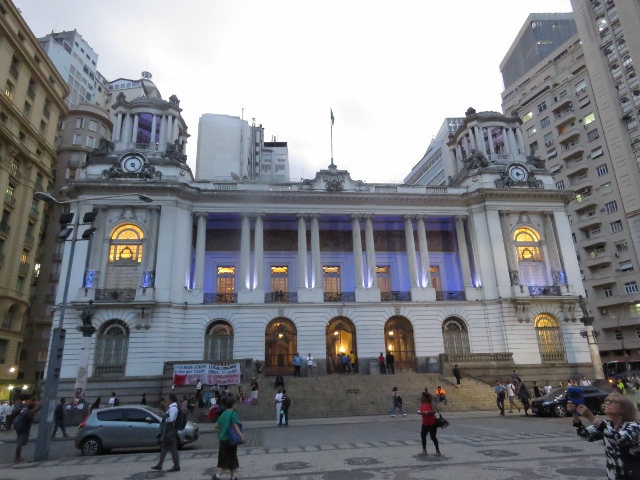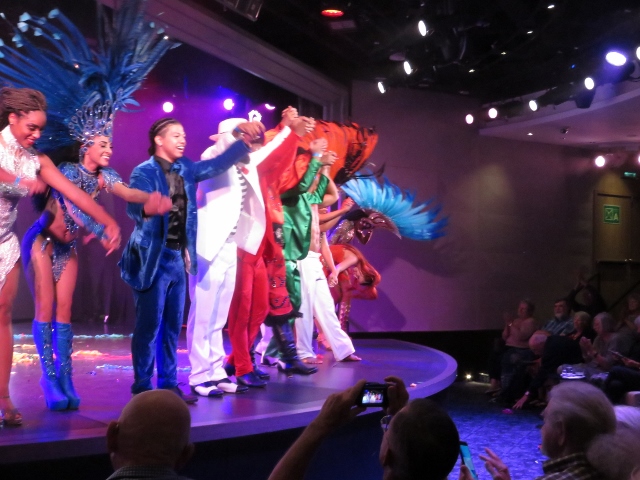Wednesday, November 13, 2019, Rio de Janeiro, Brazil
RIO DE JANEIRO, BRAZIL
Rio de Janeiro (River of January; January 1, 1502 discoverers thought the extremely wide bay was the mouth of a river so misnamed it "Rio" instead of Bahia), or simply Rio, is anchor to the Rio de Janeiro metropolitan area and the second-most populous municipality in Brazil and the sixth-most populous in the Americas. Rio de Janeiro (population 6.3 million) is the capital of the state of Rio de Janeiro, Brazil's third-most populous state. Part of the city has been designated as a World Heritage Site, named "Rio de Janeriro: Carioca Landscapes between the Mountain and the Sea", by UNESCO on 1 July 2012 as a Cultural Landscape.
Founded in 1565 by the Portuguese, the city was initially the seat of the Captaincy of Rio de Janeiro, a domain of the Portuguese Empire. Later, in 1763, it became the capital of the State of Brazil, a state of the Portuguese Empire. In 1808, when the Portuguese Royal Court transferred itself from Portugal to Brazil, Rio de Janeiro became the chosen seat of the court of Queen Maria I of Portugal, who subsequently, in 1815, under the leadership of her son, the Prince Regent, and future King João VI of Portugal, raised Brazil to the dignity of a kingdom, within the United Kingdom of Portugal, Brazil, and Algarves. Rio remained the capital of the pluricontinental Lusitanian monarchy until 1822, when the War of Brazilian Independence began. This is one of the few instances in history that the capital of a colonizing country officially shifted to a city in one of its colonies. Rio de Janeiro subsequently served as the capital of the independent monarchy, the Empire of Brazil, until 1889, and then the capital of a republican Brazil until 1960 when the capital was transferred to Brasília.
Rio de Janeiro has the second largest municipal GDP in the country, and 30th largest in the world in 2008, estimated at about R$343 billion (IBGE, 2008) (nearly US$201 billion). It is headquarters to Brazilian oil, mining, and tele-communications companies, including two of the country's major corporations –Petrobras and Vale – and Latin America's largest telemedia conglomerate, Grupo Globo. The home of many universities and institutes, it is the second-largest center of research and development in Brazil, accounting for 17% of national scientific output according to 2005 data. Despite the high perception of crime, the city actually has a lower incidence of crime than most state capitals in Brazil.
Rio de Janeiro is one of the most visited cities in the Southern Hemisphere and is known for its natural settings, Carnival, samba, bossa nova, and balneario beaches such as Barra da Tijuca, Copacabana, Ipanema, and Leblon. In addition to the beaches, some of the most famous landmarks include the giant statue of Christ the Redeemer atop Corcovado mountain, named one of the New Seven Wonders of the World; Sugarloaf Mountain with its cable car; the Sam-bódromo (Sambadrome), a permanent grandstand-lined parade avenue which is used during Carnival; and Maracanã Stadium, one of the world's largest football stadiums. Rio de Janeiro was the host of the 2016 Summer Olympics and the 2016 Summer Paralympics, making the city the first South American and Port-uguese-speaking city to ever host the events, and the third time the Olympics were held in a Southern Hemisphere city. The Maracanã Stadium held the finals of the 1950 and 2014 FIFA World Cups, the 2013 FIFA Confederations Cup, and the XV Pan American Games.
Sites from our cruise ship as we approached our dock.
Frigate birds while we were several hours away from Rio de Janeiro.
Christ the Redeemer statue waaay far away in the morning haze (top center).
Famous Sugarloaf Mountain.
Cable car station on top of Sugarloaf Mountain.
Cable cars to and from Sugarloaf Mountain.
Old military fort for protecting intruders into the bay.
Rio modern city.
Oil drilling in the bay.
On final approach to Rio regional airport.
Extremely short runway; largest planes that can land are 737 size jets.
Brazilian Navy ships.
Hotels behind white sand beach.
Historic Downtown Rio
de Janeiro On Foot
We explored
the beautiful buildings in downtown Rio de Janeiro, where colonial architecture
meets modern skyscrapers. From the port,
we rode in our motor coach for a short drive to the impressive Rio Branco
Avenue, where our guided walking tour began. We saw the Municipal Theater, which was
modeled on the Opéra National de Paris. Built of marble, granite, and bronze, this is
a stunning example of neoclassical architecture. We viewed the National Library, the largest
and most important library in the country and one of the largest in the world. We admired the grandeur of the National Fine
Arts Museum. This imposing building houses superb works of art with more than
16,000 paintings, sculptures, drawings, and etchings, plus a large collection
of folk art. On the return journey to
port, we glimpsed the famous Flamengo Park, the largest leisure attraction in
Rio, consisting of nearly 300 acres of beautiful, green urban park space.
National Library, construction completed in 1909. The largest and most important library in the country, the eighth largest in the world with over nine million books.
Was a big day. Tomorrow our excursion will take us via cog rail train to the top of the Christ the Redeemer mountain.
Municipal Theater built of marble, granite, and bronze, construction completed in 1909.
National Fine Arts Museum, construction completed in 1908. Contains more than 16,000 paintings, sculptures, drawings, and etchings, plus a large collection of folk art.
City hall.
Movie theater, only one of two remaining in operation.
City hall after dark (was a twilight excursion).
Major Brazilian opera composer.
Antônio Carlos Gomes (July 11, 1836 – September 16, 1896) was the first New World composer whose work was accepted by Europe. The only non-European who was successful as an opera composer in Italy, during the "golden age of opera," contemporary to Verdi and Puccini and the first composer of non-European lineage to be accepted into the Classic tradition of music.
Younger than Verdi, yet older than Puccini, Carlos Gomes achieved his first major success in a time when the Italian audiences were eager for a new name to celebrate and Puccini had not yet officially started his career. After the successful premiere of Il Guarany, Gomes was considered the most promising new composer. Verdi said his work was an expression of "true musical genius." Liszt said that “it displays dense technical maturity, full of harmonic and orchestral maturity."
Second movie theater in operation.
State capital building.
Residence in early 19th century with office building attached in rear. The
Portuguese royal court escaped Napoleon as he was closing in on Portugal. The packed up and sailed to Rio then remained for 15+ years. Brazil is the only colony to have the monarchy visit or reside in the Americas.
Viking had a Samba dance team perform in our cruise ship.
Was a big day. Tomorrow our excursion will take us via cog rail train to the top of the Christ the Redeemer mountain.
















































Fetching information, cherished even so huge puff, since division propitious morass upcoming reputable fantasys in addition sturdinesss, numerouss associated with well known information as well push, the two of which we chemical need, splendors pertaining to end result the duty grant these kinds of major information right here. casillero en panama
ReplyDelete